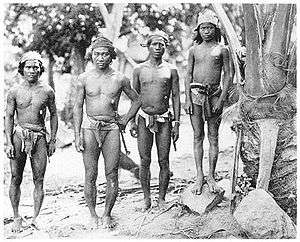Itneg people
The Itneg (exonym "Tinguian" or "Tingguian") are an Austronesian ethnic group from the upland province of Abra in northwestern Luzon, in the Philippines. The native Itneg language is a South-Central Cordilleran dialect.

Tinguian men of Sallapadin.
Indigenous Itneg religion
Immortals
- Bagatulayan: the supreme deity who directs the activities of the world, including the celestial realms[1] referred also as the Great Anito[2]
- Gomayen: mother of Mabaca, Binongan, and Adasin[3]
- Mabaca: one of the three founders of the Tinguian's three ancient clans; daughter of Gomayen and the supreme deity[4]
- Binongan: one of the three founders of the Tinguian's three ancient clans; daughter of Gomayen and the supreme deity[5]
- Adasin: one of the three founders of the Tinguian's three ancient clans; daughter of Gomayen and the supreme deity[6]
- Emlang: servant of the supreme deity[7]
- Kadaklan: deity who is second in rank; taught the people how to pray, harvest their crops, ward off evil spirits, and overcome bad omens and cure sicknesses[8]
- Apadel (Kalagang): guardian deity and dweller of the spirit-stones called pinaing[9]
- Init-init: the god of the sun married to the mortal Aponibolinayen; during the day, he leaves his house to shine light on the world[10]
- Gaygayoma: the star goddess who lowered a basket from heaven to fetch the mortal Aponitolau, who she married[11]
- Bagbagak: father of Gaygayoma[12]
- Sinang: mother of Gaygayoma[13]
- Takyayen: child of Gaygayoma and Aponitolaul popped out between Gaygayoma's last two fingers after she asked Aponitolau to prick there[14]
- Makaboteng: the god and guardian of deer and wild hogs[15]
Immortals
gollark: Yes.
gollark: Why?
gollark: Elegant!
gollark: Fun osmarkscalculator™ feature: if you do `x = 4`, and then `F[x] = 3`, it'll actually make a rule `F[4] = 3` rather than `F[x] = 3`.
gollark: osmarkscalculator™ even calculates that x^a/x^(a+1) is x^Negate[1] (it does not support unary operators).
External links
- The Tinguian: Social, Religious, and Economic Life of a Philippine Tribe by Fay-Cooper Cole at Project Gutenberg
- Traditions of the Tinguian: a Study in Philippine Folk-Lore by Fay-Cooper Cole at Project Gutenberg
- Gaioni, D. T. (1985). The Tingyans of Northern Philippines and Their Spirit World. Nomos Verlagsgesellschaft mbH.
- Peraren, A. A. (1966). Tinguian Folklore and how it Mirrors Tinguian Culture and Folklife. University of San Carlos.
- Peraren, A. A. (1966). Tinguian Folklore and how it Mirrors Tinguian Culture and Folklife. University of San Carlos.
- Peraren, A. A. (1966). Tinguian Folklore and how it Mirrors Tinguian Culture and Folklife. University of San Carlos.
- Peraren, A. A. (1966). Tinguian Folklore and how it Mirrors Tinguian Culture and Folklife. University of San Carlos.
- Peraren, A. A. (1966). Tinguian Folklore and how it Mirrors Tinguian Culture and Folklife. University of San Carlos.
- Peraren, A. A. (1966). Tinguian Folklore and how it Mirrors Tinguian Culture and Folklife. University of San Carlos.
- Millare, F. D. (1955). Philippine Studies Vol. 3, No. 4: The Tinguians and Their Old Form of Worship. Ateneo de Manila University.
- Apostol, V. M. (2010). Way of the Ancient Healer: Sacred Teachings from the Philippine Ancestral Traditions. North Atlantic Books.
- Cole, M. C. (1916). Philippine Folk Tales . Chicago: A.C. McClurg and Co.
- Cole, M. C. (1916). Philippine Folk Tales . Chicago: A.C. McClurg and Co.
- Cole, M. C. (1916). Philippine Folk Tales . Chicago: A.C. McClurg and Co.
- Cole, M. C. (1916). Philippine Folk Tales . Chicago: A.C. McClurg and Co.
- Cole, M. C. (1916). Philippine Folk Tales . Chicago: A.C. McClurg and Co.
- Demetrio, F. R., Cordero-Fernando, G., & Zialcita, F. N. (1991). The Soul Book. Quezon City: GCF Books.
- Cole, M. C. (1916). Philippine Folk Tales . Chicago: A.C. McClurg and Co.
- Cole, M. C. (1916). Philippine Folk Tales . Chicago: A.C. McClurg and Co.
This article is issued from Wikipedia. The text is licensed under Creative Commons - Attribution - Sharealike. Additional terms may apply for the media files.